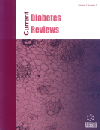- Home
- A-Z Publications
- Current Diabetes Reviews
- Previous Issues
- Volume 20, Issue 10, 2024
Current Diabetes Reviews - Volume 20, Issue 10, 2024
Volume 20, Issue 10, 2024
-
-
Association and Mechanisms of Proton Pump Inhibitors Use with Type-2 Diabetes Mellitus Incidence in Adults: A Systemic Review and Meta-Analysis
More LessBackground: Proton pump inhibitors (PPIs) are an extensively prescribed class of anti-ulcer drugs. This systematic review aimed to investigate the association between PPI use and the risk of new-onset diabetes mellitus or type 2 diabetes (T2DM) incidence. Methods: A comprehensive literature search was conducted in PubMed, Scopus, Cochrane Library, and ClinicalTrials.gov using the search terms “proton pump inhibitor,” “prot Read More
-
-
-
Type 2 Diabetes Prevalence, Control and Management within Fiji, Kiribati, Samoa, the Solomon Islands, Tonga, and Vanuatu: A Scoping Review with a Systematic Approach
More LessBy Timothy KuekBackground: Type 2 diabetes (T2D) causes significant morbidity and is disproportionately prevalent in Pacific Island Countries (PICs). The socio-political demographics of PICs are rapidly changing, and health services must adapt to match the needs of their population. Objectives: The objective of this study was to review the literature published within the last 15 years relating to T2D prevalence, control, and manageme Read More
-
-
-
Empagliflozin-A Sodium Glucose Co-transporter-2 Inhibitor: Overview of its Chemistry, Pharmacology, and Toxicology
More LessAuthors: Jyoti Yadav, Farogh Ahsan, Prabhudatta Panda, Tarique Mahmood, Vaseem A. Ansari and Arshiya ShamimBackground: Empagliflozin is a sodium glucose co-transporter-2 (SGLT2) inhibitor that has gained significant attention in the treatment of type 2 diabetes mellitus. Understanding its chemistry, pharmacology, and toxicology is crucial for the safe and effective use of this medication. Objective: This review aims to provide a comprehensive overview of the chemistry, pharmacology, and toxicology of empagliflozin, synthesizing th Read More
-
-
-
Therapeutic Interventions to Improve Static Balance in Type 2 Diabetes Mellitus: A Systematic Review and Meta-Analysis
More LessIntroduction: Diabetes mellitus (DM) is a metabolic disorder characterized by an abnormal increase in blood glucose levels resulting from insulin secretion and/or dysfunctional activity that can lead to several serious complications in addition to decreased postural balance. Objective: This study aimed to identify and analyze the main interventions used to improve static balance in patients with DM. Methods: For the selectio Read More
-
-
-
Unravelling the Crosstalk between Estrogen Deficiency and Gut-biota Dysbiosis in the Development of Diabetes Mellitus
More LessAuthors: Rishabh, Seema Bansal, Akriti Goel, Sumeet Gupta, Deepti Malik and Nitin BansalEstrogens are classically considered essential hormonal signals, but they exert profound effects in a number of physiological and pathological states, including glucose homeostasis and insulin resistance. Estrogen deficiency after menopause in most women leads to increased androgenicity and changes in body composition, and it is recommended to manipulate the β-cell function of the pancreas, insulin-induced glucose tran Read More
-
-
-
The Counteracting Effects of Ang II and Ang-(1-7) on the Function and Growth of Insulin-secreting NIT-1 Cells
More LessAuthors: Xiuhong Lin, Xiaoyun Wang, Weilian Feng, Yan Wan, Jiani Chai, Feng Li and Mingtong XuIntroduction: China now has the highest number of diabetes in the world. Angiotensin II (Ang II) causes insulin resistance by acting on the insulin signaling pathway of peripheral target tissues. However, its effect on islet β-cells remains unclear. The possible role of Angiotensin-( 1-7) [Ang-(1-7)] as an antagonist to the effects of Ang II and in treating diabetes needs to be elucidated. Objectives: To assess the effects of Ang II and A Read More
-
-
-
Glp-1 Mimetics and Autophagy in Diabetic Milieu: State-of-the-Art
More LessAuthors: Habib Yaribeygi, Mina Maleki, Raul D. Santos, Tannaz Jamialahmadi and Amirhossein SahebkarThe diabetic milieu is associated with cascades of pathophysiological pathways that culminate in diabetic complications and tissue injuries. Autophagy is an essential process mandatory for cell survival and tissue homeostasis by degrading damaged organelles and removing injured cells. However, it may turn into a pathological process in an aberrant mode in the diabetic and/or malignant milieu. Moreover, autophagy coul Read More
-
-
-
Association between Gut Microbiota Compositions with Microvascular Complications in Individuals with Diabetes: A Systematic Review
More LessBackground: Diabetes is one of the chronic and very complex diseases that can lead to microvascular complications. Recent evidence demonstrates that dysbiosis of the microbiota composition might result in low-grade, local, and systemic inflammation, which contributes directly to the development of diabetes mellitus and its microvascular consequences. Objective: The aim of this systematic review was to investiga Read More
-
Volumes & issues
-
Volume 21 (2025)
-
Volume 20 (2024)
-
Volume 19 (2023)
-
Volume 18 (2022)
-
Volume 17 (2021)
-
Volume 16 (2020)
-
Volume 15 (2019)
-
Volume 14 (2018)
-
Volume 13 (2017)
-
Volume 12 (2016)
-
Volume 11 (2015)
-
Volume 10 (2014)
-
Volume 9 (2013)
-
Volume 8 (2012)
-
Volume 7 (2011)
-
Volume 6 (2010)
-
Volume 5 (2009)
-
Volume 4 (2008)
-
Volume 3 (2007)
-
Volume 2 (2006)
-
Volume 1 (2005)
Most Read This Month
Article
content/journals/cdr
Journal
10
5
false
en


